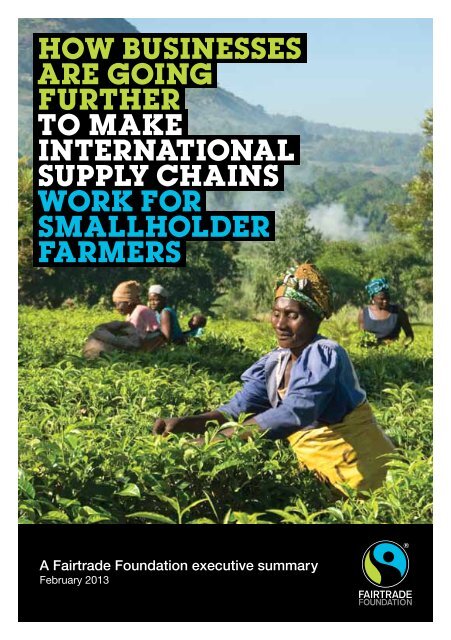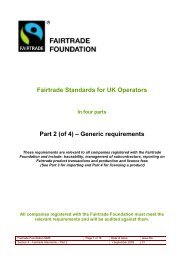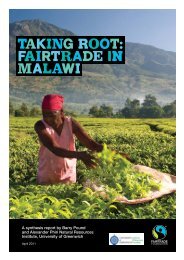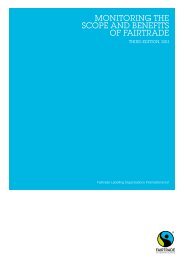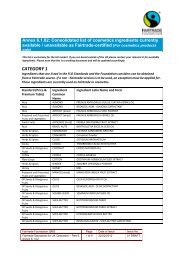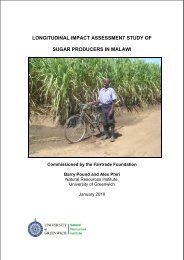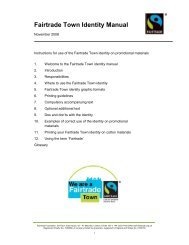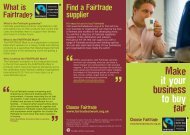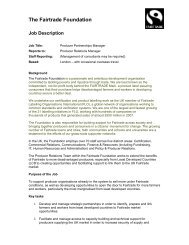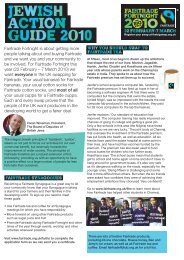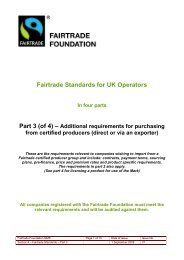executive summary - The Fairtrade Foundation
executive summary - The Fairtrade Foundation
executive summary - The Fairtrade Foundation
You also want an ePaper? Increase the reach of your titles
YUMPU automatically turns print PDFs into web optimized ePapers that Google loves.
How businesses<br />
are going<br />
furtHer<br />
to make<br />
international<br />
supply cHains<br />
work for<br />
smallHolder<br />
farmers<br />
A <strong>Fairtrade</strong> <strong>Foundation</strong> <strong>executive</strong> <strong>summary</strong><br />
February 2013
<strong>executive</strong> <strong>summary</strong><br />
This paper comes at a time when there is increasing recognition<br />
among business and government in the role smallholder farmers<br />
can play in a truly sustainable food and farming system.<br />
For the past thirty years it has been<br />
hard for smallholder farmers and their<br />
partners to challenge the assumption<br />
that urbanisation of population and the<br />
industrialisation of agriculture are the only<br />
pathways for development and this view<br />
was a major cause of the erosion of the<br />
technical, financial and marketing services<br />
on which smallholder farmers depended.<br />
<strong>The</strong>se assumptions are still prevalent<br />
in many countries but there is growing<br />
interest in an alternative and the feedback<br />
from commercial stakeholders surveyed<br />
for this report indicates a greater shared<br />
perspective on the major global sustainability<br />
challenges, including the need for social and<br />
environmental justice, than at any time since<br />
the FAIRTRADE Mark was launched in 1994.<br />
In the five years to 2012 the <strong>Fairtrade</strong><br />
<strong>Foundation</strong> has been pursuing an ambitious<br />
strategy towards its vision that everyone,<br />
through their work, should be able to<br />
maintain a decent and dignified livelihood<br />
and fulfill their potential. <strong>The</strong> Tipping the<br />
Balance strategy has extended the scope of<br />
<strong>Fairtrade</strong> to more small farmers and workers<br />
and increased impact for those already<br />
engaged with <strong>Fairtrade</strong> through impressive<br />
growth in awareness of the FAIRTRADE Mark<br />
and sales of <strong>Fairtrade</strong> products. In 2011,<br />
public awareness of the FAIRTRADE Mark<br />
in the UK reached 78 per cent and sales of<br />
certified products in the UK amounted to<br />
£1.3 billion 1 , generating over £20 million in<br />
<strong>Fairtrade</strong> Premium payments to producers.<br />
Over 300 of the 991 producer organisations<br />
certified worldwide to international <strong>Fairtrade</strong><br />
standards supply the UK market, which by<br />
most measures is the most successful of its<br />
kind in the world. 2<br />
In the next phase of its work, the <strong>Fairtrade</strong><br />
<strong>Foundation</strong> will continue to scale up its work<br />
with producers and companies, but will<br />
also explore broader, qualitative change in<br />
trading relationships between UK businesses<br />
and smallholder farmers in Africa, Asia and<br />
Latin America that support the development<br />
needs and aspirations of rural families<br />
and communities. An important part of<br />
the preparation for that work is to look at<br />
how smallholder farmers and companies<br />
can establish sustainable and equitable<br />
relationships across highly demanding and<br />
fast-moving international supply chains. This<br />
paper builds on an earlier policy report by<br />
Twin 3 that considered the experience and<br />
perspective of small farmer organisations<br />
and contributed to a multi-stakeholder forum<br />
in May 2012. This second phase of the work<br />
has been developed through discussions<br />
with commercial stakeholders and analysis<br />
of their feedback by senior management at<br />
the <strong>Foundation</strong>.<br />
<strong>The</strong> interviews and discussions undertaken<br />
for this report have highlighted the exciting<br />
opportunities that are emerging for the<br />
<strong>Fairtrade</strong> <strong>Foundation</strong> to facilitate deeper<br />
collaboration that furthers the goals of<br />
smallholder organisations, businesses,
Nofita Chikodzera tends her groundnut crop, Malawi<br />
consumers, civil society agencies and<br />
donors. Most important for its mission to<br />
support smallholders to take more control<br />
over their lives and determine their own<br />
futures, at a time when more companies are<br />
recognising the need to invest in smallholder<br />
farmer initiatives, is to highlight the important<br />
role of democratic organisations, such as<br />
co-operatives, in representing their members<br />
in planning, prioritising and implementing<br />
improvements. Examples identified in this<br />
report illustrate how partnerships with, and<br />
investment in, smallholder organisations<br />
improves the chances of interventions also<br />
delivering the economic return that business<br />
needs as well as supporting the aims and<br />
aspirations of the families and communities<br />
concerned. This is the ‘win-win’ that typifies<br />
<strong>Fairtrade</strong> at its best, reinforcing the business<br />
case for <strong>Fairtrade</strong> while bringing a business<br />
perspective to sustainable development work.
key insigHts<br />
1. A holistic view of<br />
supply chains<br />
<strong>The</strong> supply chains that connect smallholders<br />
to mainstream consumer markets are often<br />
a web of interdependent relationships and<br />
there is an increasing need to take a holistic<br />
view of their internal structures and to<br />
understand the interdependencies. This<br />
is especially important when retailers and<br />
large brands use intermediaries to manage<br />
their relationships with smallholder groups,<br />
which can limit their understanding of<br />
how their actions may affect smallholders,<br />
and vice versa. While buying direct from<br />
smallholders may not always be practical<br />
in every supply chain, there is increasing<br />
recognition of the need to have more direct<br />
communication and sharing of information<br />
among all the links of the chain, with the aim<br />
of using greater transparency to strengthen<br />
mutual accountability.<br />
2. Aligning the aims and<br />
objectives of all parties<br />
While the different stakeholders in supply<br />
chains may share many long-term<br />
objectives, there are also significant<br />
differences. For most businesses smallholder<br />
farmers are little more than the first link in<br />
their product supply chains, whereas farming<br />
families view trade not only as a means of<br />
generating income but also of sustaining and<br />
developing the social and cultural fabric of<br />
their communities. <strong>The</strong> earlier report<br />
identified different smallholder strategies of<br />
strengthening their existing market positions,<br />
diversifying their production, transitioning to<br />
new ways of income generation, describing<br />
these, respectively, as ‘hanging on, stepping<br />
up and stepping out’. If the differences as<br />
well as the commonalities are not adequately<br />
understood there is a risk that investments,<br />
for example in increasing productivity or<br />
quality, may not be aligned with the needs<br />
and priorities of smallholder groups and their<br />
wider communities. This can limit the<br />
chances of their success or undermine<br />
the efforts of smallholders to make their<br />
own choices.<br />
3. Beyond minimum<br />
standards<br />
<strong>The</strong> activities needed to address points<br />
1 & 2 sit firmly in the area beyond<br />
compliance with minimum requirements<br />
of <strong>Fairtrade</strong> standards for traders and<br />
licensees towards deeper commitment,<br />
although they are very much in tune with<br />
the development aims of the latest standards<br />
for smallholder organisations. 4<br />
As good practice in this area becomes<br />
established, this could be reflected in a<br />
raised minimum threshold for businesses,<br />
provided the cost or complexity of<br />
certification was not unduly increased; this<br />
ensures a level playing field in which the<br />
committed are not undercut by the merely<br />
compliant. However, this is an ongoing<br />
process and some companies will always<br />
be piloting work beyond minimum standards<br />
and would like to communicate this to<br />
consumers. While the FAIRTRADE Mark<br />
plays a vital role in providing a clear and<br />
specific guarantee that helps consumers<br />
identify products that meet its standards<br />
from other products in the market, new ways<br />
of differentiating the brands that ‘go further’<br />
than the minimum would be welcome.
Marvin Cascante Lobo, coffee farmer, Costa Rica
going furtHer:<br />
Questions for business<br />
Based on these insights, this report discusses<br />
ways in which businesses can go further<br />
to make international supply chains work<br />
for smallholder farmers and what support<br />
they need from government, civil society<br />
organisations and the <strong>Fairtrade</strong> system to<br />
do this. In looking at how some progressive<br />
businesses are overcoming the barriers to<br />
closer engagement with smallholder farmers,<br />
the following questions have come to the<br />
fore. <strong>The</strong>y are discussed at greater length<br />
in the body of the report and six case studies<br />
are presented as illustrative examples. <strong>The</strong><br />
many different contexts in which smallholders<br />
operate, the different products they grow,<br />
and varying modes in which they are traded<br />
make it impossible to present one single best<br />
practice model that can be applied universally.<br />
Rather these insights are presented to inform<br />
and inspire the debate that is needed on<br />
this subject and offer potential directions<br />
for businesses wishing to take their<br />
commitments deeper.<br />
1. How can the business case<br />
for investing in smallholder<br />
farmer organisations as<br />
social actors be better<br />
recognised and supported?<br />
<strong>The</strong> role that democratic organisations play<br />
in helping smallholder farmers take more<br />
control over their future, and invest in building<br />
sustainable local farming communities for the<br />
future, has long been recognised by the fair<br />
trade movement and in <strong>Fairtrade</strong> standards.<br />
<strong>The</strong> examples discussed in the main report,<br />
such as Tate & Lyle Sugars’ experience in<br />
Belize show how some mainstream companies<br />
are also embracing this approach while<br />
others are attracted by the faster results of<br />
establishing their own groups to implement<br />
improvement programmes despite the risks<br />
of creating dependencies.<br />
2. How can the different<br />
operating contexts of<br />
smallholder farmer<br />
organisations and large<br />
brands and retailers<br />
be better understood<br />
and aligned?<br />
<strong>The</strong> challenges of aligning the different<br />
timescales to which smallholder farmers<br />
and retailers operate were cited by many<br />
companies who have to bridge this gap in<br />
supply chains. Retailers are typically making<br />
decisions about individual products and<br />
ranges on the basis of a few weeks’ figures;<br />
indeed their ability to respond quickly to<br />
changes in consumer demand is a critical<br />
factor in the success of their businesses.<br />
At the other end of the chain, collecting<br />
and analysing information to understand<br />
problems and building up the capacity of<br />
producer organisations to implement plans to<br />
correct them and strengthen their operations<br />
is a much more difficult and time-consuming<br />
process. Companies working most closely<br />
with producers noted the efforts required to<br />
develop a shared understanding of these<br />
issues and wanted those closer to the market<br />
to take more account of smallholder farmers’<br />
context by making longer-term commitments<br />
and allowing a realistic period for investments<br />
to generate changes.
3. How can the transparency<br />
of supply chains be<br />
increased for the benefit<br />
of all participants?<br />
Transparency was mentioned frequently by<br />
commercial stakeholders and was prominent<br />
in developing the case for a more holistic<br />
approach to supply and value chains in order<br />
for them to become more equitable and<br />
sustainable. This starts with traceability of the<br />
origins and destinations of products which<br />
should develop into increased transparency<br />
about what the different parties bring and<br />
take to the value chain. Market demands for<br />
physical traceability of products is increasing<br />
as consumers express more interest in<br />
the provenance of products and retailers<br />
and brands want to monitor the results of<br />
their interventions to improve production<br />
practices, but there is even more pressure for<br />
transparency around the flow of money, value<br />
addition and impact between the parties at<br />
each link of the chain. <strong>The</strong> <strong>Fairtrade</strong> system<br />
itself is part of this broader value chain and<br />
several businesses stressed the importance<br />
of robust information about how smallholder<br />
organisations used their <strong>Fairtrade</strong> Premium,<br />
especially those that received very large<br />
amounts such as the largest certified<br />
organisations working in sugar and cocoa,<br />
as well as on the transactional costs and<br />
benefits of the <strong>Fairtrade</strong> system itself.<br />
4. How can transparency be<br />
developed into mutual<br />
accountability across the<br />
whole supply chain?<br />
While transparency was raised frequently<br />
as a headline issue by many stakeholders,<br />
further discussions demonstrated that<br />
this is invariably a means to an end; and<br />
the real objective is mutual accountability,<br />
including sharing of effort, risk and reward.<br />
While companies have legitimate interests<br />
in being able to assess the impact of<br />
<strong>Fairtrade</strong> Premium investments and other<br />
activities delivered by the <strong>Fairtrade</strong> system,<br />
there is less recognition of a similar desire<br />
Isaac Frimpong, member of Kuapa Kokoo, Ghana
Fayson Tchale picking tea, Malawi
Oliva Kishero on her coffee farm in Uganda<br />
among their supply chain partners for<br />
greater accountability of the brands and<br />
retailers as the recipients of the largest<br />
share of the final price paid by consumers.<br />
Smallholders have also raised this issue in<br />
the context that extended supply chains in<br />
which they have little or no information on<br />
the ultimate destination of their products<br />
make it impossible for them to hold retailers<br />
and brands to account. <strong>The</strong>re is a business<br />
case to be made for companies to lead by<br />
example on this as it will provide traction<br />
for the investments companies are making<br />
in helping smallholders improve yields and<br />
returns by raising productivity and quality,<br />
and to ensure that suppliers – all the way<br />
back to smallholder organisations – do not<br />
see pressure for greater transparency and<br />
traceability as simply aimed at increasing<br />
the power of buyers. Fair Trade Organisations<br />
advocate direct relationships with smallholder<br />
organisations as the best way of ensuring<br />
mutual accountability, with several wishing<br />
to expand their service offer to companies,<br />
while the Ben & Jerry’s case study indicates<br />
the opportunity to increase transparency<br />
and accountability while working<br />
through intermediaries.<br />
5. How can more and better<br />
partnerships be developed<br />
to help smallholder<br />
organisations develop their<br />
full potential through fair<br />
and sustainable trade?<br />
<strong>The</strong> need for more and better collaboration to<br />
tackle sustainability issues was unquestioned<br />
by the stakeholders interviewed for this<br />
report. <strong>The</strong> challenges of securing longterm<br />
product supplies while helping farmers<br />
play their part in this while coping with<br />
climate change, food security and increasing<br />
scarcity of oil, water and other resources<br />
were recognised as too complex for any<br />
single actor to address effectively. <strong>The</strong>re is<br />
a need for both good technical expertise to<br />
improve productivity, quality and sustainable<br />
agricultural practices of individual farmers<br />
and of high calibre work to strengthen<br />
the capacity of farmer organisations to<br />
manage these processes autonomously<br />
and independently. Interviews for this<br />
report identified important learning from<br />
collaborations such as the work that Marks<br />
& Spencer and Finlay’s have done with<br />
DfID’s FRICH fund, the Co-operative Group’s<br />
programme of support for smallholder<br />
organisations and Cafédirect’s work with<br />
donors and farmers in São Tomé.
6. What economic interventions<br />
are needed to support more<br />
sustainable sourcing from<br />
smallholders?<br />
Price stability remains important in enabling<br />
farmers to sustain investment in improved<br />
yields and quality, which, if they can sell<br />
the additional output at viable prices, will<br />
significantly improve their overall returns. Most<br />
companies in products like coffee and cocoa,<br />
which are supplied mostly by smallholders,<br />
Deles Gussie, Dominica. Gussie is diversifying<br />
into grapefruits, coffee and spices to help<br />
sustain his business during difficult times<br />
recognise that if their sector can’t deliver a<br />
decent income for growers then few people<br />
will be growing those crops in ten or twenty<br />
years time. Despite a lift in prices over the past<br />
five years in many commodities, most farmers’<br />
experience is of 30 years of declining prices<br />
and long periods of dramatic slumps to well<br />
below the cost of production and even now<br />
prices in real terms for most crops remain far<br />
below those of the 1970s. This means that<br />
farmers are often sceptical about taking land<br />
out of production and replanting it for higher<br />
future yields with no guarantee that they will
e able to sell a higher volume at a good<br />
price. Although some companies express<br />
concern that <strong>Fairtrade</strong>’s minimum price and<br />
premium mechanism could act as a distortion<br />
of market dynamics if taken to scale, it is<br />
clear it can provide incentives for investment,<br />
as the experience of Liberation and Tate &<br />
Lyle Sugars demonstrates. Many companies<br />
also had not fully appreciated the scarcity of<br />
accessible, timely and affordable financial<br />
tools for smallholder organisations. Prefinance<br />
has always been a requirement of <strong>Fairtrade</strong><br />
standards but while the supply of working<br />
capital through social lenders such as Shared<br />
Interest and Oikocredit has increased it has not<br />
done so in line with the growth of the <strong>Fairtrade</strong><br />
market and is not always sufficient to cope<br />
with periods of volatile price movements.<br />
7. How can <strong>Fairtrade</strong> standards<br />
and communication around<br />
the FAIRTRADE Mark better<br />
support companies who<br />
go further than minimum<br />
<strong>Fairtrade</strong> standards?<br />
<strong>The</strong> interviews demonstrated a wide range of<br />
needs and expectations among companies<br />
of what the <strong>Fairtrade</strong> system should deliver<br />
in the future; indeed in several cases there<br />
was some confusion about what it currently<br />
provides. Examples of companies ‘going<br />
further’ than minimum <strong>Fairtrade</strong> standards<br />
feature prominently in this report and some<br />
companies suggested their practices should<br />
be made obligatory. This would create a more<br />
level playing field and reduce what they see as<br />
unfair competition from companies who do not<br />
Water pump funded by <strong>Fairtrade</strong><br />
cocoa sales, CONACADO,<br />
Dominican Republic<br />
invest to the same extent in producer support<br />
and capacity building, in sharing of information<br />
and assisting with access to finance. At the<br />
same time, no-one is seeking to add to the<br />
cost of the <strong>Fairtrade</strong> system at a time of<br />
growing pressures on disposable incomes<br />
for most UK families.<br />
As the <strong>Fairtrade</strong> system embarks on the<br />
process of improving its work with smallholder<br />
farmers, it looks forward to a constructive<br />
dialogue on the issues and welcomes the ideas<br />
of its commercial stakeholders to turn thinking<br />
into action.<br />
References:<br />
1. UK <strong>Fairtrade</strong> sales figures for 2012 are available on 25<br />
February 2013 – check www.fairtrade.org.uk for latest<br />
information<br />
2. <strong>Fairtrade</strong> International has 25 members who are responsible<br />
for promoting the FAIRTRADE Mark to markets (in addition<br />
to three members for Africa, Asia and Latin America whose<br />
primary role is representing producer organisations). <strong>The</strong><br />
performance of market-facing members is measured by<br />
overall sales of <strong>Fairtrade</strong> products (where Britain is ranked<br />
#1) and sales per capita<br />
3. Making international supply chains work for smallholder<br />
farmers: A comparative study of six fair trade value chains<br />
(<strong>Fairtrade</strong> <strong>Foundation</strong>, May 2012)<br />
4. In May 2011, <strong>Fairtrade</strong> International introduced a new<br />
standards framework for Small Producer Organisations,<br />
with a stronger emphasis on producers selecting their own<br />
development priorities as part of a process of continuous<br />
improvement over time. <strong>The</strong> full standard is available at<br />
www.fairtrade.net/942.html
Acknowledgments: This report was written by Ian Bretman and edited by the<br />
<strong>Fairtrade</strong> <strong>Foundation</strong>. Paul Holland, Simon Appleby, Dr Stephanie Hime, Lois Watts and<br />
George Rodwell at KPMG conducted the company interviews and are supporting this project<br />
on a pro-bono basis. <strong>The</strong> <strong>Fairtrade</strong> <strong>Foundation</strong> wishes to thank the many individuals and<br />
companies who agreed to take part in the research and also acknowledges the support of<br />
Twin and <strong>The</strong> Co-operative Group in the first stage of this project.<br />
<strong>Fairtrade</strong> <strong>Foundation</strong>, 3rd Floor, Ibex House,<br />
42-47 Minories, London EC3N 1DY<br />
T: +44 (0) 20 7405 5942 F: +44 (0) 20 7977 0101<br />
W: www.fairtrade.org.uk E: mail@fairtrade.org.uk<br />
<strong>The</strong> <strong>Fairtrade</strong> <strong>Foundation</strong> Registered Charity Number: 1043886.<br />
VAT Reg No: 672 5453 23. Company Reg. in England & Wales No. 2733136<br />
Photography credits: Monika Berresheim, Simon Rawles, Linus Halgren,<br />
Anette Kay, Eduardo Martino, Zed Nelson


